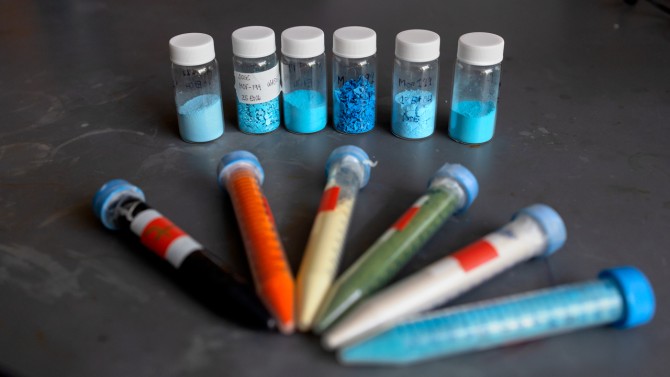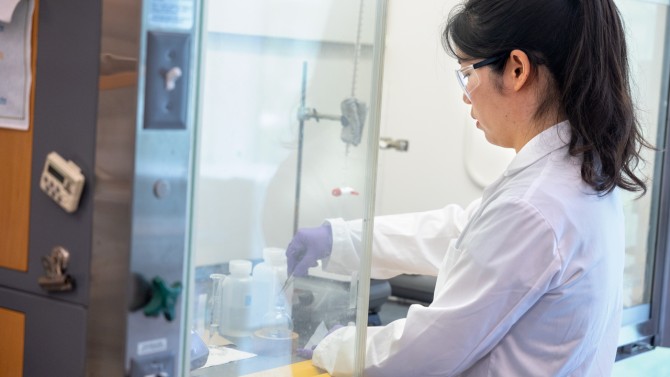Juan Hinestroza, the Rebecca Q. Morgan ’60 Professor of Fiber Science and Apparel Design, and a multidisciplinary team of Cornell chemists and engineers have created a way to break down old polyester clothing and reuse some of its compounds to make a variety of new products - and to disrupt the cycle of textile waste proliferation.
Blamed for fouling the environment, polyester may help save it
By Blaine Friedlander, Cornell Chronicle
More than a decade ago, jet-lagged textile expert Juan Hinestroza landed in Xintang, China, and took a walk near a large creek. He noticed the water was a strange color – indigo blue, from highly toxic dyes, pigments and finishes dumped from a neighboring textile factory.
“People’s faces appeared blue. The houses were blue. The air was blue. Textile plants throw contaminants in the rivers – where people swim, where people get their drinking and cooking water,” says Hinestroza, the Rebecca Q. Morgan ’60 Professor of Fiber Science and Apparel Design in the College of Human Ecology.
“That’s when I knew I had to switch the focus of my research,” he says. “As a chemical engineer and a textile chemist, I realized I could help solve some of these complex problems – they do not magically disappear.”
Now Hinestroza and a multidisciplinary team of Cornell chemists and engineers are reaching into a chemistry toolbox to clean up another formidable environmental foe: polyester textile waste.
The team has created a way to break down old polyester clothing and reuse some of its compounds to make fabrics that are fire resistant, anti-bacterial or wrinkle-free – and to halt the proliferation of garment waste in landfills.
It’s a circular approach that is in line with the United Nations Environment Programme, which has begun a worldwide effort to end the developed world’s overconsumption of clothing. The number of times clothing gets worn has decreased 36% in the past two decades, according to the program.
In 2015, the U.S. Environmental Protection Agency estimated that each person in the United States discards more than 70 pounds of textiles annually. What’s worse, the report said, more than 85% of textile waste settles in landfills.
“Eventually, we are going to run out of space,” Hinestroza says. “We’re going run out of countries where we can send our textile garbage. The consequences are quite sad, but the solution is possible and it is in ourselves.”
Disrupting business as usual
Yelin Ko stands before the quiet hum of a laboratory fume hood in the Human Ecology Building and faces three magnetic stirrers. She loads a thimble full of colorful strips of polyester fabrics into a small round-bottom flask and then pours a sodium hydroxide solution to cover the textile.
With agitation, a little applied heat, ethanol and cooling water, those tiny pieces of polyester cloth – made of polyethylene terephthalate, the kind of goop from which plastic soda bottles also are made – will become a laboratory soup.
The scientists can then extract the old fabric’s monomers from the soup and use them to create linkers to be assembled into metal-organic frameworks, or MOFs. These MOF structures can be used to create coatings on clothing that protect people from germs or noxious gases, to shield firefighters from fire or other uses not yet imagined, says Ko, a doctoral student in the field of fiber science and a Fulbright Scholarship recipient who works in Hinestroza’s laboratory.
“Instead of using toxic solvents to recover the monomers to link the MOFs, we’re using ethanol and water as solvents – and we’re reclaiming the monomers significantly faster,” she says.
Phill Milner, assistant professor of chemistry and chemical biology in the College of Arts and Sciences, and Jin Suntivich, associate professor of materials science and engineering in Cornell Engineering, are also working with Hinestroza to develop these new chemistry techniques.
“With the right metal salts, like some copper salts, we can chemically grab the organic molecule from the monomers recovered from these digested textiles,” Milner said.
Within 30 minutes the polyester is depolymerized – safely and without environmental destruction – at room temperature.
“The chemistry is all governed by this idea of self-assembly, which is that the components themselves want to become an ordered structure,” Milner says. The scientists add copper salts to an acid to create a precursor solution, which they then bring to the soup of depolymerized polyester. “The natural process keeps going until it builds an extended structure – the MOFs – which is what comes out of the solution.”
The team believes that the new techniques can disrupt the business-as-usual textile and apparel processes, which they say are unsustainable, says Suntivich, an electrochemist and material scientist. “Plastic recycling is a challenge obviously, so we’re going about it in this context. I’m seeing MOFs as just a way for me to enable the recycling of the material.”
However, the professors know that to succeed, their technique must be adaptable to existing industry practices, Hinestroza says.
Ideally, the team hopes that manufacturers use the MOF chemistry in existing infrastructure. “Trying to incorporate new equipment into new processes is always difficult,” he says. “You can develop a unique chemistry, but if you need new equipment to process the material, then there will be a lot of resistance.”
Cleaning water using textiles
Textiles incorporating these MOFs can also clean up dyed and polluted waters, Hinestroza says.
To make that happen, he’s bringing together the new chemistry techniques and his expertise in filtration and fiber science.
In earlier research projects, Hinestroza had created naturally fibrous materials to selectively capture or decompose harsh contaminants like dyes from textile manufacturing, arsenic from fracking, mercury and cyanide from coal mining, and insecticides and fertilizers from agricultural production.
The seed of those projects was planted while Hinestroza was traveling in his native Colombia. He noticed that large bags for packaging coffee beans were made from a strong fiber called fique. Under a microscope, the fiber revealed cavities where manganese oxide can loiter. When the fibrous cloth was placed in polluted water, the manganese oxide decomposed 99% of the indigo dye within minutes – making the water clear.
Looking for a local material that would do the same thing, Hinestroza thought to use fiber made from the peels of Cortland apple grown at Cornell Orchards and the stems of grapes sold at the Ithaca Farmers Market. Six years ago, he showed how nanorods created using those natural materials could also decompose toxins in waterways.
Hinestroza thinks the same concept, but using the MOF textiles, could help halt some of the pollution generated through textile and apparel manufacturing.
“In addition to places in Asia, I’ve seen Dantesque scenarios of pollution in locations like Tirappur, India, and many other locations Central America,” Hinestroza says.
“I’ve seen the colors of the rivers run purple, green or pink,” he says. “Sometimes there is truth in humor, as you can tell which colors are fashionable in New York or Paris by looking at the rivers in some of these textile mill towns.”
Some fashion companies claim to be environmentally friendly on their social media channels, Hinestroza says, but the reality is quite different. ”Educational institutions – like Cornell – are uniquely positioned to offer science-based solutions capable of addressing these complex problems.
“We have to proactively find answers for this business, and that is a key motivation for our research work,” Hinestroza says. “The menacing problem is not only the waste generated in future textile and apparel production, but also the waste and pollution that has been already generated, which will not suddenly vanish.”
Media Contact
Get Cornell news delivered right to your inbox.
Subscribe



